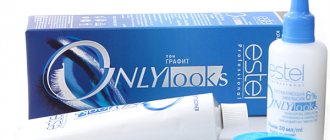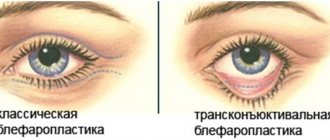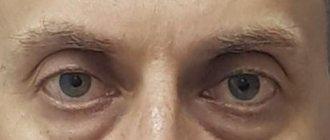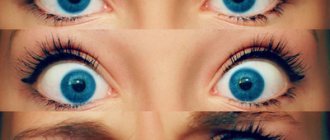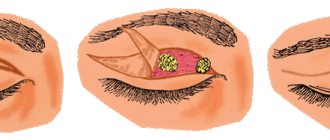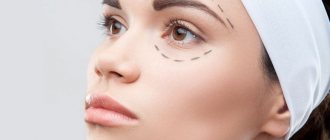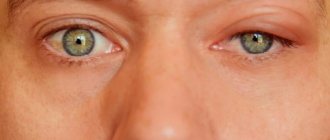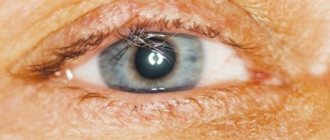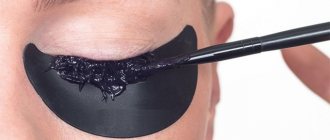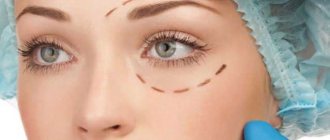Where are the cuts made?
Regardless of the type of blepharoplasty, incisions are made in the natural folds of the eyelids. This allows you to hide traces of exposure as much as possible. Of course, they cannot be hidden completely. But a competent specialist is able to perform the operation in such a way that the scars will be difficult to see if you don’t know what to look for.
Transconjunctival blepharoplasty differs from other types of correction. During the operation, the doctor makes incisions on the mucous membrane (on the inside of the eyelid). Therefore the seams are not visible.
This is the only type of blepharoplasty with invisible stitches. In other cases, the scars will disappear only two months after the operation.
How do scars heal after blepharoplasty?
In the first 4 weeks after blepharoplasty, scars, although it is more accurate to call them postoperative scars, go through a granulation phase, when new, “young” connective tissue, rich in small vessels, forms at the site of the incision. As a result, by the end of the first month, the incision site turns into a pink scar. Over the next month and a half, the scar is organized, turning it into a thin white line that barely protrudes above the surface of the skin.
In rare cases where scars are healing too slowly, your doctor may recommend revision of the surgical scar to eliminate excess connective tissue growth.
Healing
Modern plastic surgery in most cases offers suturing with self-absorbing threads. Stitches made with such threads do not need to be removed.
If the surgeon works with a regular thread, suture removal will be scheduled for 4-6 days after surgery.
The healing process is divided into three phases:
- Exudative phase
Duration: 5-7 days after surgery.
During this period, the patient may feel that his health is getting worse every day. The swelling is growing. Blueness and hyperemia may appear.
During this period, the risk of sutures coming apart or bleeding is especially high.
To eliminate possible complications, it is necessary to ensure proper care of the sutures. The plastic surgeon will tell you how to do this.
2. Granulation
Duration: about a month.
The period of formation of new connective tissue. By the end of the phase, a pink scar forms at the site of the suture.
3. Scar discoloration
Duration: 1 month.
During this period, the scar gradually turns white. By the end of the period, it turns into a barely noticeable thin line.
As you can see, the healing process takes about two months. The sutures will heal completely and the scars will smooth out 10-12 weeks after blepharoplasty.
Eyelid surgery: indications and types of operations
Surgeries on the upper and lower eyelids are usually of a rejuvenating nature.
They are carried out if there are signs of aging of the skin and soft tissues of the area around the eyes, which include an increase in the volume of fatty hernias, the appearance of “bags” and “bruises” under the lower eyelids, drooping of the upper eyelids. Modeling operations are carried out to increase the width/height of the eyes, correct the “eastern cut”, and change the inclination of the palpebral fissure. Blepharoplasty is performed through surgical access, which is carried out from the outer or inner surface of the eyelids. In the first case, the incisions are made along the ciliary edge (for lower blepharoplasty) or along the natural folds of the skin (for upper eyelid blepharoplasty). Due to the specificity of the blepharoplasty approach, the scars are hidden from prying eyes; Over time, the scars fade and become completely invisible.
With transconjunctival plastic surgery, surgical access is carried out from the conjunctiva, and therefore there are no visible scars on the facial skin. For upper eyelid blepharoplasty, transconjunctival access is not used.
The patient's responsible attitude to the rules of the rehabilitation period helps to minimize the risk of complications after surgery and speed up wound healing. It is important to follow the recommendations of the plastic surgeon throughout the entire recovery period after blepharoplasty, until the integumentary tissues are completely healed. Therefore, it is important to find out before surgery how rehabilitation is going and how to speed up the healing process.
Caring for seams
I think you have a general idea about caring for seams. In most cases, the algorithm of actions is the same and simple.
As with any other plastic procedure, after blepharoplasty the doctor applies a sterile dressing to the stitches.
At the same time, experts recommend applying cold compresses to the affected areas. This will reduce swelling.
You will be allowed to wash your face only the next day. And cold water. And so that the bandage and stitches remain dry.
Next, if everything is fine with the stitches, the doctor will either remove the stitches, or (if the threads are self-absorbing) will tell you in detail what will happen to them.
In addition, the specialist will explain how to treat seams at home.
To speed up the healing process, special ointments and creams may be prescribed.
It is important here not to self-medicate. Use only medications approved by your surgeon.
Inevitable difficulties: swelling and bruising
The patient spends the first day after blepharoplasty in the clinic’s inpatient unit. In theory, you can return home on the day of surgery, but surgeons do not recommend doing this. Physician supervision immediately after surgery is very important in terms of minimizing the risk of complications and improving the aesthetic result of the correction.
The main difficulties for the patient are associated with the inevitable consequences of violation of the integrity of the integumentary tissues - swelling, pain and hematomas. After eyelid surgery, all these symptoms are present; the degree of their severity depends on the specifics of the surgical intervention, the age of the patient, and the individual reaction of the body.
To reduce the symptoms mentioned above, the plastic surgeon prescribes anti-inflammatory drugs. To reduce swelling, cold compresses can be applied to the eyelids on the third or fourth day after the procedure. A course of antibiotics is indicated to prevent infection. It is important to regularly put antiseptic drops into your eyes. You only need to wash your face with boiled water or herbal decoctions, such as chamomile.
A specific symptom of the rehabilitation period after blepharoplasty is dryness of the conjunctiva and a feeling of “sand” in the eyes. Some patients face the opposite problem and complain of increased tearing. These consequences do not pose a threat to health, but measures must be taken to help normalize the functioning of the lacrimal glands.
To speed up recovery after blepharoplasty, it is necessary to minimize the load on the visual analyzer. Try not to read, watch less TV, limit the time you work with a computer or smartphone. If possible, avoid rooms with bright lighting. At home, turn on dim lights.
Dressing for 5-7 days.
On the dressing we see that the skin has healed perfectly, the process of epithelization has completely occurred. The seam looks like a thin narrow pink stripe, which will turn white over time and become even less noticeable. We see that the cut is located in the correct position, in the fold, which also ensures its inconspicuousness. But at the same time, we see that the skin fold at this stage is swollen, that is, there is a little more skin than needed due to swelling. The patient asks me: “Sergei Vladimirovich, was it possible to remove more skin?” How to answer this question? Of course it is possible, but then there would be a void in the upper eyelid, which would give age, rather than a rejuvenation effect. If I removed all the skin, we would get significant changes in the upper eyelids and this could become very unusual for the patient and the patient could be upset, but most importantly, there would be an emptiness effect. The skin of the upper eyelids is now swollen, stretched, and the skin hurts. But when 4 months pass and the swelling completely goes away and the skin of the upper eyelid shrinks. The excess that exists will go away in 4-6 months due to skin contraction. In addition, we need a small excess so that we can perform a brow lift in the future. If we completely remove all the skin and then we decide to perform an endoscopic brow lift, a situation may arise where there is not enough skin, there will be excess tension. In this situation, there will be contraindications for a brow lift, so in this case the skin is removed with the expectation that the next brow lift operation will be performed and the skin will be completely straightened, and there will be no excess, and there will be no emptiness of the upper eyelid, this is very important to plan sequence of the operation and at each stage to obtain a good aesthetic result.
Care
Immediately after blepharoplasty, a sterile dressing is applied to the stitches. To reduce the formation of swelling, doctors advise applying ice compresses to the operated area in the first days. At this time, cosmetic and hygiene procedures on the face are contraindicated. You are allowed to wash your face no earlier than the next day.
We recommend: Why do black circles appear after lower blepharoplasty?
It is better to use cold water, rinsing the skin so that water does not get on the bandage and stitches. The procedure is useful to do, as it increases blood circulation and activates skin regeneration. It is usually necessary to use additional medications (ointments, creams, furatsilin solution for disinfection).
Skin care after suture removal consists of:
- the use of medications that accelerate healing (Levomekol ointment);
- using hypoallergenic and non-comedogenic products to cleanse the fatty ducts of the skin.
- applying creams that increase the elasticity of the skin;
- salon procedures - on the 5th day you can do a massage that stimulates blood circulation and accelerates the process of skin regeneration;
- additional procedures - treatment of hematoma or hemorrhage areas with Lyoton ointment for 7 days, but so that it does not get on the sutures.
Gel Lyoton
If the sutures after blepharoplasty do not tighten, then make sure that you follow the doctor’s recommendations:
- do not go to saunas and steam baths - if there is postoperative inflammation, then such activities only aggravate it;
- do not lift weights, do not take on heavy physical exertion, do not bend forward (all this contributes to the divergence of the seams);
- do not rub the operated area - firstly, this may cause infection in the wound, and secondly, it may delay treatment.
It is also extremely important in the first days after the procedure not to be in the open sun, not to go to the solarium. Wear sunglasses when going outside.
Much has been said about the negative impact of ultraviolet radiation on the process of tightening scars after surgery. The sun's rays promote strong collagen synthesis, making the scar dark and prominent.
If the patient’s medical history has a tendency to develop hypertrophic or keloid scars, the surgeon may prescribe additional procedures - inject the drug into the scar area or prescribe additional medications to prevent the proliferation of connective tissue: silicone-based ointments and gels (Zeraderm, Contractubex), silicone patch. In addition, they accelerate lightening and smooth out scars after blepharoplasty.
We recommend: What complications can occur after blepharoplasty?
In extreme cases, if the smoothing process is delayed, the surgeon performs a revision of the scar, which consists of removing excess connective tissue.
YouTube responded with an error: The request cannot be completed because you have exceeded your quota.
Rate this article:
- Related Posts
- What to do if ptosis appears after blepharoplasty?
- Why do my eyes itch after blepharoplasty?
- Is blepharoplasty dangerous?
- Can hollows form under the eyes after blepharoplasty?
- Why do black circles appear after lower blepharoplasty?
- What complications can occur after blepharoplasty?
Contraindications to upper blepharoplasty
Contraindications to blepharoplasty include only serious systemic diseases:
- Oncology;
- Diseases of the cardiovascular system;
- Impaired liver and kidney function;
- Poor blood clotting.
As for eye diseases, almost none of them are considered contraindications to surgery. The exception is inflammatory diseases such as conjunctivitis. It is worth noting that a temporary contraindication for surgery is any inflammatory process in the body.
How is the operation performed?
A plastic surgeon can perform blepharoplasty in two ways - using a laser or classically (using a scalpel). Both of these methods have the same number of advantages. Laser surgery does not imply the complete absence of bruises, swelling and postoperative stitches. If an operation was performed on the body, especially with the removal of excess tissue, then there will be stitches, swelling and bruises regardless of how it was performed.
Laser is considered a new, more convenient way to perform surgery. For the surgeon, it is of great importance whether the operation is performed with a laser or scalpel. The patient will not notice any difference if blepharoplasty was performed by a competent and qualified surgical team.
The operation is performed under local (very rarely general) anesthesia with intravenous sedation. The incision during upper blepharoplasty runs along the natural crease of the eyelid, so those faint scars that the operation will leave behind will be additionally hidden. In order for anyone to be able to see these scars, they need to be specifically demonstrated.
When performing blepharoplasty, the doctor performs the following manipulations (one or all):
- Excision of excess skin (a small oval-shaped area is removed);
- Plastic surgery of the eyelid muscles. It involves either partial displacement of the muscle to the upper position, or excision of its excess;
- Removal of excess fatty tissue.
The duration of upper blepharoplasty is 1-2 hours.
OPERATION.
Local anesthesia.
Incision.
Removal of hernias and excess skin.
A piece of skin from the upper eyelid.
Applying a suture.
Applying strips for fixation.
The operation is completed.
Rest in the ward after surgery.
Cosmetologist-rehabilitologist Irina Tkacheva (Moscow) talks about how to speed up healing and influence the formation of scars after eyelid surgery.
If
blepharoplasty is transconjunctival and there are no stitches, you can begin rehabilitation from 2-3 days. If there are stitches, after they are removed, this is often 6-7 days.
In any case, magnetic and microcurrent therapies are needed first.
Magnetic therapy is non-contact, it can be started from 2-3 days, and then microcurrents can be added. They increase the energy of the cell, affect all metabolic processes in it, improve venous and lymphatic flow, and can relieve pain. A course of at least 5 procedures, 2 times a week.
At 2 weeks ,
when scar formation has begun, you can add phonophoresis or electrophoresis (also performed using a microcurrent apparatus), as well as use a low-intensity Vitalaser laser.
D
Even if the surgeon very delicately applied the sutures, and they are hardly noticeable in the first days, after 2-4 weeks the suture may become redder and thicker, which means hypertrophic scar formation. Normal skin cells are replaced by pathological ones with high activity of collagen synthesis. A rough fibrous scar is formed (but do not confuse hypertrophy with keloid).
Hypertrophic scars
can be formed both due to local reasons (inflammation, slow healing) and on the scale of the entire organism (individual reactions to injury, deficiency conditions). But it is possible to influence the course of scarring. And here physical therapy in combination with drugs that affect scar formation will help. For example, the company Medicalia has created a number of such products. Or Kelo-cote, Dermatix, which contain silicones that inhibit the development of hypertrophy.
We usually start phonophoresis (therapeutic ultrasound) at 2-3 weeks. It also has a beneficial effect on scars, as it is able to improve microcirculation, soften tissue, and promote the penetration of medicinal and cosmeceutical drugs (Diprospan, Lidaza, Fermenkol).
Surgeons say: “You don’t need to do anything, the suture will dissolve on its own.” Yes, the scar will still lighten over time, but what its aesthetic appearance will be depends on prevention. The greater the hypertrophy, the denser and wider the scar, the wider it will spread after the hypertrophy resolves.
.
So:
1. We start with microcurrents and perform lymphatic drainage.
2. When the swelling goes down (in the first 2 weeks after the operation, and with the help of microcurrents the swelling can go away in a week), a scar begins to form: it is by 2 weeks that the seam becomes red. Then we add phonophoresis and drugs that directly affect the seam to the microcurrents.
3. If the scar is dense, red, thickens, pulls the tissue, then, in agreement with the surgeon, injection methods of treatment (botulinum toxin), laser correction of the scar (1 month after surgery) are used.
This is the minimum after which you can rest assured that the seam will be barely noticeable.
H
As for the “round eye,” if the surgeon made a mistake, nothing can be done: with true eversion of the eyelid, only surgical correction can help (and even then not always). If the inversion is caused by a roughly formed scar that pulls back the lower eyelid, we can influence it. With the help of injections, physiotherapy, and laser treatment, the scar softens, relaxes, and the eyelid is raised to its original position.
After operation
After eyelid surgery, a bandage is applied and eye drops are instilled to prevent swelling. There is no pain, bed rest is recommended for the next 2-3 hours. The cosmetic micro-suture is removed by pulling on 4-5 days absolutely painlessly. By the 6-7th day, minor swelling disappears and you can return to everyday life.
But according to most patients, the final result is determined only by the second or third month.
